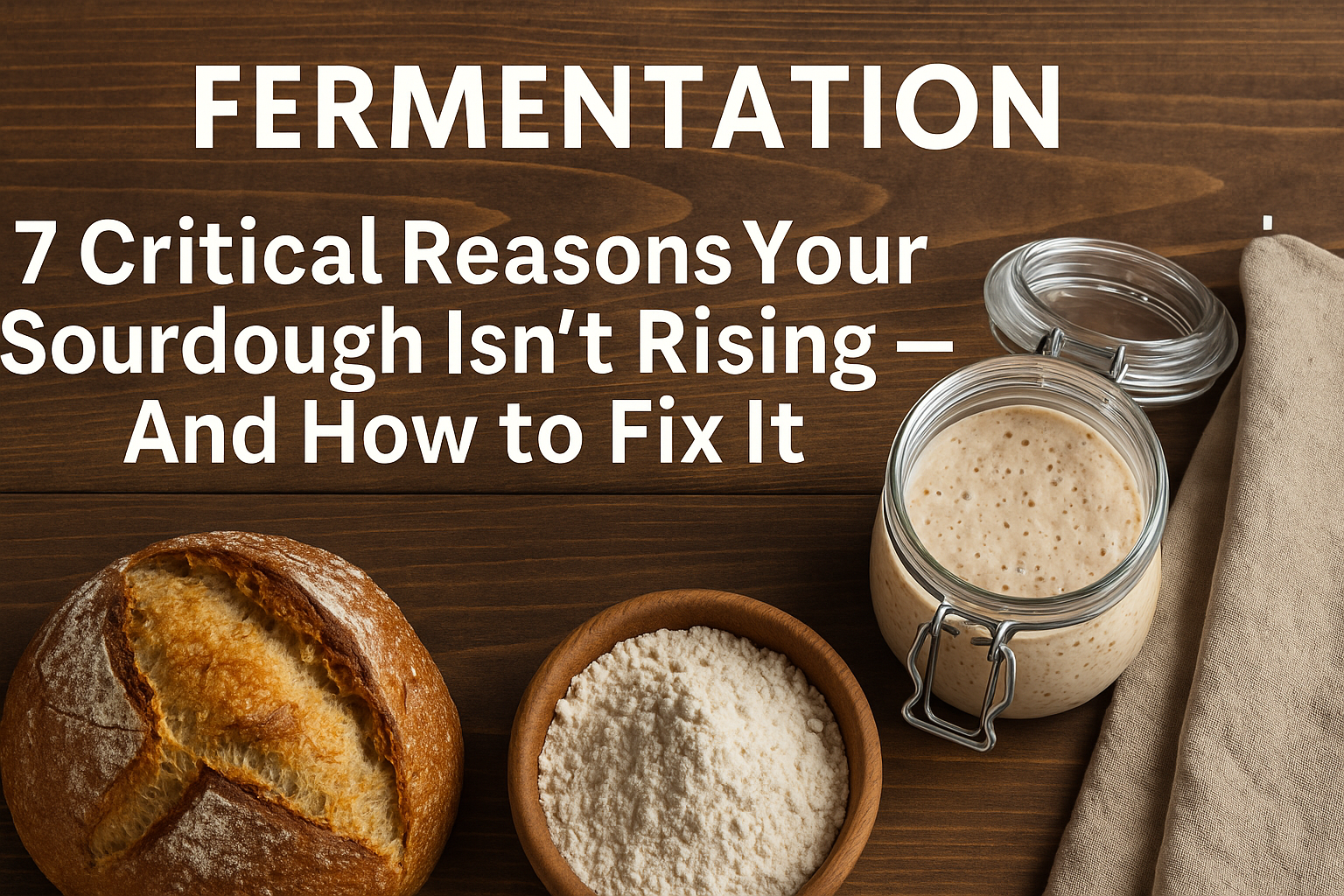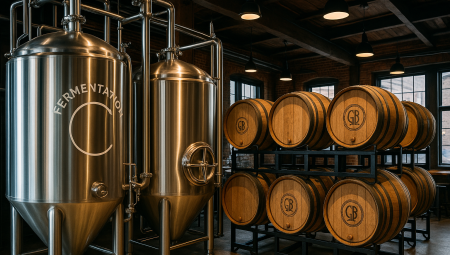Many home bakers dream of that perfectly airy, tangy sourdough loaf with a beautiful oven spring. Yet, few things are as disheartening as a sourdough that simply isn’t rising during bulk fermentation. You’ve fed your starter, mixed your dough, and now, hours later, it’s just… sitting there. This comprehensive guide will delve into the most common culprits behind a sluggish sourdough rise and provide actionable solutions to ensure your next loaf reaches its full, glorious potential.
Why Isn’t My Sourdough Rising During Bulk Fermentation?
Bulk fermentation, often considered the heart of sourdough baking, is the initial rise of your dough after mixing. It’s during this crucial stage that the yeast and bacteria in your sourdough starter get to work, producing carbon dioxide that creates those coveted air pockets and gives your bread its signature texture. When this process stalls, it can be incredibly frustrating. The good news is, in most cases, the issue is identifiable and fixable.
The Power of Your Sourdough Starter: Is It Active Enough?
One of the primary reasons your sourdough isn’t rising during bulk fermentation is a weak or inactive starter. Your starter is the engine of your bread; if it’s sluggish, your dough will be too.
How to Assess Your Sourdough Starter’s Vitality
A healthy, active sourdough starter should exhibit several key signs:
- Doubling (or Tripling) in Size: After feeding, a strong starter should consistently double or even triple in size within 4-8 hours at room temperature (around 70-75°F or 21-24°C). If it’s barely bubbling or showing minimal growth, it’s not ready for baking.
- Bubbles Galore: Look for abundant bubbles throughout the starter, not just on the surface. These indicate active fermentation.
- Pleasant Aroma: A healthy starter smells slightly tangy, yeasty, and sometimes even a bit fruity. An off-putting, acetone-like, or overly acidic smell can indicate an imbalance or starvation.
- Float Test: While not foolproof, a small dollop of ripe starter dropped into a glass of water should float. This suggests it’s full of gas and ready to leaven.
What to Do If Your Starter is Weak
If your starter is underperforming, it needs some tender loving care before you attempt another bake.
- Consistent Feeding Schedule: Feed your starter regularly (daily if kept at room temperature) with a consistent ratio of flour, water, and starter. A common ratio is 1:1:1 (e.g., 50g starter, 50g water, 50g flour).
- High-Quality Flour: Use unbleached, unbromated flour. Whole wheat or rye flours can be particularly good for strengthening a starter due to their higher nutrient content.
- Optimal Temperature: Keep your starter in a warm spot (75-80°F or 24-27°C) to encourage yeast activity. A proofing box or oven with the light on (and door ajar to prevent overheating) can help.
- Discarding: Make sure you’re discarding enough of your starter before feeding. This ensures the available “food” goes to the most active microorganisms. Aim to keep a smaller amount (e.g., 50-100g) and feed it adequately.
Understanding Dough Temperature: The Unsung Hero of Fermentation
Temperature is perhaps the single most critical factor influencing bulk fermentation. Yeast and bacteria are microorganisms, and like all living things, they have optimal temperature ranges for activity. A dough that is too cold will ferment slowly, if at all, leading to a flat, dense loaf.
The Ideal Dough Temperature Range
For most sourdoughs, an ideal dough temperature (also known as the “desired dough temperature” or DDT) during bulk fermentation is between 75-80°F (24-27°C). Below 70°F (21°C), fermentation significantly slows down. Above 80°F (27°C), it can become too rapid, leading to over-fermentation, a loss of flavor complexity, and an undesirable crumb structure.
How to Control Dough Temperature
- Warm Water: Use warm water (not hot!) for mixing your dough. If your kitchen is cool, slightly warmer water (e.g., 90-95°F or 32-35°C) can help bring the dough up to temperature.
- Kitchen Environment: Find the warmest spot in your kitchen. This could be near a sunny window (but out of direct, intense sunlight), on top of a refrigerator, or in a dedicated proofing box.
- Proofing Box/Oven with Light On: Many bakers use a proofing box or simply turn on their oven light (without heat) to create a warm, consistent environment for their dough. Always be careful not to overheat the dough – check the temperature periodically.
- Container Material: Glass or ceramic bowls retain heat better than plastic.
Hydration Levels: A Double-Edged Sword
The amount of water in your dough (hydration) plays a significant role in its texture and how it ferments. While higher hydration often leads to a more open crumb, it can also make the dough harder to handle and, crucially, impact its ability to hold gas.
Low Hydration: A Stiff Challenge
A very low hydration dough (e.g., below 65%) can be quite stiff. This stiffness makes it more difficult for the yeast to expand the gluten network and create volume, leading to a slower and less dramatic rise.
High Hydration: Structure is Key
Conversely, a very high hydration dough (e.g., above 80%) requires excellent gluten development to trap gas effectively. If the gluten isn’t strong enough, the gas will escape, and your dough won’t rise. In such cases, the problem isn’t the fermentation itself but the dough’s structural integrity.
Finding the Right Balance
- Start Simple: If you’re new to sourdough, begin with a moderate hydration level (70-75%) until you get a feel for the process and can reliably develop gluten.
- Adjust Water Gradually: Don’t add all the water at once. Hold back a small amount and incorporate it gradually as you mix, feeling how the dough develops.
- Focus on Gluten Development: For higher hydration doughs, ample stretching and folding during the initial stages of bulk fermentation are crucial to build a strong gluten network.
Gluten Development: The Foundation of Rise
Gluten is the protein network in flour that provides structure and elasticity to your dough. It’s what allows the dough to trap the carbon dioxide produced by the yeast, causing it to rise. Without proper gluten development, your dough will be slack, unable to hold gas, and will struggle to gain volume.
Signs of Poor Gluten Development
- No Windowpane: After mixing and some initial folds, you should be able to gently stretch a small piece of dough thin enough to see light through it without tearing (the “windowpane test”). If it tears easily, the gluten isn’t developed enough.
- Lack of Elasticity: The dough feels lifeless and doesn’t spring back when gently pressed.
- Soupy or Slack Texture: Even after resting, the dough remains very loose and doesn’t hold its shape.
How to Improve Gluten Development
- Autolyse: This technique involves mixing just the flour and water and letting it rest for 30-60 minutes before adding the starter and salt. This allows the flour to fully hydrate and gluten to begin forming without interference from salt.
- Stretching and Folding: Instead of traditional kneading, sourdough bakers often use a series of “stretch and folds” during the early stages of bulk fermentation. This gently develops gluten while preserving the delicate structure. Perform 3-6 sets of stretch and folds, spaced 30-60 minutes apart, depending on your dough and desired outcome.
- Dough Strength: Pay attention to how your dough feels. It should become increasingly smooth, elastic, and able to hold its shape as you perform folds.
The Salt Factor: Too Much, Too Soon, or Too Little?
Salt is essential for flavor and also plays a crucial role in controlling fermentation and strengthening the gluten network. However, its timing and quantity are critical.
Salt’s Impact on Yeast Activity
Salt can inhibit yeast activity if added directly to the starter or in excessive amounts. It draws water out of yeast cells, slowing down their metabolic processes.
Best Practices for Salt Addition
- Add Later: Always add salt after incorporating your sourdough starter and allowing it to mix for a few minutes. This gives the yeast a head start before the salt begins to exert its effects.
- Standard Ratio: A typical salt ratio for sourdough is 1.8-2.2% of the total flour weight. Too much salt can significantly slow down or even halt fermentation. Too little can result in a bland loaf with a sticky crumb.
- Dissolve First: If you’re concerned about salt granules impacting fermentation, you can dissolve the salt in a small amount of the dough’s water before adding it.
Over-Proofing vs. Under-Proofing: The Fermentation Sweet Spot
One of the trickiest aspects of sourdough is knowing when bulk fermentation is complete. Both under-proofing and over-proofing can lead to a lack of rise in your final loaf, though for different reasons.
Under-Proofing: Not Enough Gas
An under-proofed dough simply hasn’t had enough time for the yeast to produce sufficient carbon dioxide. It will feel dense and firm, and when baked, it will have a tight, uneven crumb with a potential “gummy” texture. While it might show some rise, it won’t be optimal.
Over-Proofing: Exhausted Yeast and Collapsed Structure
An over-proofed dough, on the other hand, means the yeast has consumed most of the available sugars, and the gluten structure, stretched to its limit, begins to break down. The dough will look very bubbly, might feel jiggly and fragile, and could even show signs of collapsing in the bowl. When baked, an over-proofed loaf will often spread out (pancake effect) rather than rise, resulting in a dense crumb.
How to Tell When Bulk Fermentation is Done
This is where experience comes in, but here are some indicators:
- Visual Cues: The dough should increase in volume by 30-50% (depending on hydration and desired crumb). Look for a domed top and visible bubbles on the surface.
- Texture: It should feel light, airy, and slightly jiggly, but still have some tension.
- Poke Test: Gently poke the dough with a wet finger. If the indentation slowly springs back halfway, it’s likely ready. If it springs back immediately, it needs more time (under-proofed). If it stays indented or collapses, it’s over-proofed.
- Time (with Caveats): While recipes provide time ranges, treat them as guidelines. The actual time needed depends heavily on your starter’s activity and, most importantly, the dough temperature.
Flour Quality and Type: The Unseen Influence
Not all flours are created equal. The type and quality of flour you use can significantly impact gluten development and, consequently, your dough’s ability to rise.
Protein Content and Gluten Strength
Flours with higher protein content (like bread flour, typically 12-14% protein) form stronger gluten networks, which are better at trapping gas. All-purpose flour (around 10-12% protein) can work, but may require more careful handling and longer fermentation.
Whole Grains: A Different Beast
Whole wheat and rye flours contain more bran and germ, which can interfere with gluten formation. While they add incredible flavor and nutrition, they often result in denser loaves and may require specific techniques (e.g., higher hydration for whole wheat, different fermentation cues for rye) to achieve a good rise.
Ensuring Flour Quality
- Unbleached/Unbromated: Always use unbleached and unbromated flours, as these chemicals can interfere with yeast activity.
- Freshness: Use fresh flour. Old flour can have reduced enzyme activity, which impacts fermentation.
- Experiment: Don’t be afraid to try different brands and types of flour to see what works best for your starter and your baking environment.
Pro Tips for a Perfect Sourdough Rise
- Keep a Baking Journal: Document your ambient temperature, water temperature, bulk fermentation time, and results. This data is invaluable for troubleshooting and refining your process.
- Invest in a Digital Thermometer: A good instant-read thermometer is crucial for accurately measuring your dough’s temperature throughout bulk fermentation.
- “Feed the Dough, Not the Clock”: Understand that bulk fermentation times are highly variable. Learn to read your dough’s cues (visual, textural, poke test) rather than relying solely on a timer.
- Master Your Starter: A strong, consistent starter is the bedrock of successful sourdough. If your starter isn’t performing, address that first.
- Gentle Handling: Especially with high-hydration doughs, handle your dough gently during stretch and folds and shaping to avoid deflating the precious gas bubbles.
- Consider a Levain: For optimal results, some bakers feed a small portion of their main starter specifically for baking (a “levain” or “leaven”). This allows you to tailor its feeding schedule to ensure peak activity for your bake.
Frequently Asked Questions About Sourdough Rising
Q1: Can cold temperatures really stop sourdough from rising?
Yes, absolutely. Yeast and bacteria are microorganisms that thrive within specific temperature ranges. Below 70°F (21°C), their metabolic activity significantly slows down, leading to a very sluggish or almost non-existent rise during bulk fermentation. Conversely, very high temperatures can lead to over-proofing too quickly. Maintaining an ideal dough temperature of 75-80°F (24-27°C) is crucial for a successful rise.
Q2: How can I tell if my sourdough starter is truly active enough for baking?
A truly active sourdough starter should consistently double or triple in size within 4-8 hours after feeding at room temperature (70-75°F or 21-24°C). You’ll also see abundant bubbles throughout the starter, not just on the surface, and it should smell pleasantly yeasty and tangy. A simple float test, where a small dollop of starter floats in water, is a good indicator of gas production, though not a definitive sign of readiness.
Q3: What’s the difference between under-proofed and over-proofed sourdough, and how does it affect the rise?
An under-proofed dough hasn’t fermented long enough; the yeast hasn’t produced enough gas, resulting in a dense, tight crumb and limited oven spring. An over-proofed dough, on the other hand, has fermented too long; the yeast has consumed most sugars, and the gluten structure, overstretched, begins to collapse. This leads to a dough that spreads out instead of rising, often resulting in a flat loaf with a dense, gummy texture. Learning to read your dough’s visual and textural cues (like the poke test) is key to finding the “sweet spot” of bulk fermentation.
Let’s Rise Together!
We hope this comprehensive guide has illuminated the common challenges of sourdough not rising during bulk fermentation and equipped you with the knowledge to troubleshoot and achieve baking success. Sourdough baking is a journey of learning and adaptation, and every bake offers valuable insights.
What has been your biggest challenge with sourdough fermentation, and what tricks have you discovered to get that perfect rise? Share your experiences and questions in the comments below – let’s help each other bake better bread!



